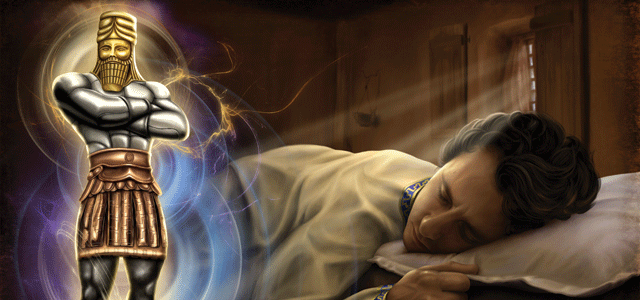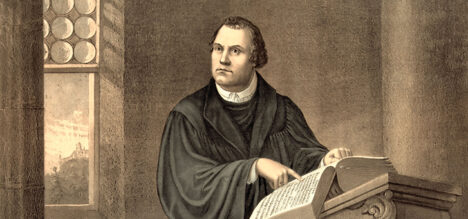
Garth Bainbridge analyses the historical accuracy of a dream from a few thousand years ago.
Assuming what the Bible claims about God is true—He knows the future just as well as if it were yesterday—then He is guiding the history of this world toward a preordained climax. And, in fact, this was the message of a dream that came to a pagan emperor, ruler of the greatest kingdom of his day, Babylon.
King Nebuchadnezzar led the armies of Babylon in conquest of nations and empires, destroying in the process the great empires of Assyria and Egypt. He conquered Judah, the southern half of the nation of Israel, and transported the cream of its youth to his capital on the Euphrates.
He was also a builder: He expanded and beautified the city of Babylon to the point where he boasted, “Is not this the great Babylon I have built as the royal residence, by my mighty power and for the glory of my majesty?” Those words are recorded in the Bible, written by Daniel (4:30), who was Nebuchadnezzar’s prime minister. Similar sentiments are embossed on many of the bricks unearthed from the ruins of his city, with an added phrase, “May it last for ever.”
But God’s word to the king was that Babylon would not in fact last forever.
Message In A Dream
One day, Nebuchadnezzar had a dream. Trying to understand what it meant, he summoned his magicians, sorcerers and astrologers. Wanting to be sure that they really did have the ability to interpret his dream, he refused to tell them what it actually contained, demanding, rather, “Tell me the dream and I will know that you can interpret it for me” (Daniel 2:9, emphasis added).
The astrologers, aghast and afraid, responded, “What the king asks is too difficult. No one can reveal it to the king except the gods, and they do not live among humans” (verse 11).
They had to admit that astrology really could not foretell the future.
The king immediately ordered the execution of the frauds. But among the recent graduates from Babylon’s school of wisdom were four young Jewish exiles who had not been summoned earlier but who nonetheless were condemned along with their colleagues. One of them, Daniel, asked the king for time so that he could interpret the dream.
That night, after praying, Daniel had the same God-inspired dream. The next morning, he appeared before Nebuchadnezzar. After reiterating the point made by his peers, that no-one on earth could possibly tell the king his dream, he pointed out that “there is a God in heaven who reveals mysteries,” adding that “He has shown King Nebuchadnezzar what will happen in days to come” (verse 28).
Then he proceeded: “Your Majesty looked, and there before you stood a large statue—an enormous, dazzling statue, awesome in appearance. The head of the statue was made of pure gold, its chest and arms of silver, its belly and thighs of bronze, its legs of iron, its feet partly of iron and partly of baked clay. While you were watching, a rock was cut out, but not by human hands. It struck the statue on its feet of iron and clay and smashed them. Then the iron, the clay, the bronze, the silver and the gold were all broken to pieces and became like chaff on a threshing floor in the summer. The wind swept them away without leaving a trace. But the rock that struck the statue became a huge mountain and filled the whole earth” (verses 31–35).
Aha, the king thought, this young man has it right.
Interpreting The Dream
The head, chest, thighs and legs, Daniel explained, represented four successive empires. And beginning with the head Babylon—“You are that head of gold” (verse 38)—he worked his way to its feet:
Head of pure gold. Nebuchadnezzar had raised Babylon to be a mighty and wealthy empire. The reconstructed Ishtar Gate in the Berlin Museum gives a view into a once glorious city. He built one of the ancient world’s seven wonders—the Hanging Gardens of Babylon—to create a more luxuriant feel to this desert-bounded city.
Yet, in the same breath, Daniel predicted its overthrow: “After you, another kingdom will arise, inferior to yours” (verse 39). Amazingly, more than 100 years before the event, the prophet Isaiah also foresaw a day when Babylon would be invaded (see Isaiah 44:26–28), even naming the person responsible for leading that army. Visit Babylon today and you will find nothing but a pile of uninhabited ruins.
Chest and arms of silver. Babylon was conquered by the combined forces of Media and Persia (led by a general named Cyrus) in 539 B.C., just 60 years after Nebuchadnezzar’s dream. This signalled the death of the golden empire and the birth of the silver—the Persian Empire.
The Persian Empire became the most extensive ever to exist, stretching from the Indus Valley in the east through to Egypt in the southwest and Thrace and Macedonia on the border of Greece. It encompassed eight million square kilometres across three continents, eventually ruling over 50 million people, or about 44 per cent of the world’s population at the time.
Belly and thighs of bronze. After a 200-year imperial rule, Persian territory began to fall to the aggressive military might of a young Macedonian king, Alexander the Great. Alexander never lost a battle and after a 10-year campaign, established Greece as the next great empire of world history. He died prematurely at the age of 33, and his empire was divided into four (this, too, was predicted by Daniel; see Daniel 8:20–22).
Legs of iron. This made it relatively easy for Rome to rise to power. The Roman standard was raised over nations across Europe and North Africa and deep into Asia. It held sway for almost 500 years. It was under a Roman government that Jesus was born; Roman-built roads carried the first Christian missionaries far and wide; the Roman Colosseum was entertained by the death of many a Christian martyr.
Feet of iron and clay. Daniel explained the meaning of the feet with their mixture of iron and clay: “Just as you saw that the feet and toes were partly of baked clay and partly of iron, so this will be a divided kingdom . . . this kingdom will be partly strong and partly brittle. And . . . the people will be a mixture and will not remain united” (verses 41–43).
Rome began to disintegrate and eventually fell to the Barbarian invasions from the north and the east. Europe became a divided continent with a multitude of governments, cultures and languages. Nations developed as proud individual entities which through the centuries have fiercely resisted all attempts to unite them under one imperial canopy.
The End
Yet, there is one more dramatic scene, one more kingdom to come—the kingdom of the Rock: “In the time of those kings, the God of heaven will set up a kingdom that will never be destroyed, nor will it be left to another people. It will crush all those kingdoms and bring them to an end, but it will itself endure forever” (verse 44).
God’s kingdom, one that will endure forever, has already arrived. Jesus came proclaiming, “The time has come. The kingdom of God has come near” (Mark 1:15). It isn’t a visible kingdom, except in the lives of people transformed by the power of its King.
Jesus came healing the iron-and-clay brokenness of human lives and God’s kingdom has continued to conquer the hearts of people in every land, bringing hope and peace and wholeness.
Yet there is more: the time is coming when the kingdom of God will become gloriously visible, when Jesus comes a second time to this earth. Then it will be time to wrap things up for this poor, broken planet of ours and to start something new.
God’s last word on that is recorded in Revelation chapter 21: “God’s dwelling place is now among the people, and he will dwell with them. . . . He will wipe every tear from their eyes. There will be no more death’ or mourning or crying or pain, for the old order of things has passed away” (verses 3, 4).









